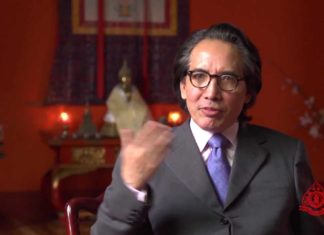Chögyam Trungpa’s first book, Born in Tibet, originally published in 1966, is a classic story of a great escape. It is an autobiographical account of Rinpoche’s upbringing in Tibet and his forced departure from the country in 1959, leading a group of 300 refugees trying to reach India. Now, more than fifty years later, Grant MacLean has created a movie for the internet (which can be found here) that brings the reality of the escape to life. Using technology from Google Earth and Flight Simulator, Touch and Go makes you feel that you are — if not on the journey — then certainly witnessing it close at hand.
If Chögyam Trungpa had not been successful in reaching India, what would have become of Buddhism in America and throughout the West? When you see how close he came to failure and how extraordinary his success was, it might give you pause.
While many Tibetan teachers and ordinary citizens walked out of Tibet in 1959 and 60, most journeys lasted a few weeks. Chögyam Trungpa’s took nine months. He and his party crossed roaring rivers and used rickety ladders to scale mountain faces and cliffs. The number of mountains they climbed — well, it’s beyond conception. The party crossed umpteen passes at 17,000 and 18,000 feet. They had no specialized mountaineering equipment or special clothing; they ranged in age from babies to octogenarians. To make a path in deep snow, the strongest among them would lay down and carve out a path for others to walk on. They got lost many times; they ran out of food and almost starved to death; they had to backtrack, sometimes for days. They had to travel at night for weeks on end. They were shot at. Some were captured. I don’t want to spoil the drama for you, so I won’t tell you all the challenges they faced. But you have to watch this. It’s epic. In fact, it’s unbelievable. I actually can’t understand how they succeeded.
Remarkably, MacLean has created a movie that has dramatic tension and tells a story that grips the audience, without anyone appearing in the film! There are a few photographs of Chögyam Trungpa and others, but mainly the movie relies on the simulated landscape and fly-overs, augmented by MacLean’s excellent script and narration, plus Trungpa Rinpoche’s own drawings and an amazing map he created of the escape route.
Many of those who attended the premiere this weekend in Halifax had read the book, some several times. (The film was projected onto a small screen, and held up amazingly well, considering that it’s made for internet viewing.) Many in the audience commented that, because of Trungpa Rinpoche’s understated writing style, they had never fully experienced or realized what an amazing escape this really was. Now you can’t miss it.
I think Trungpa Rinpoche would have liked Grant MacLean’s movie very much, for the spaciousness and the tension that it creates. In the 1970s, when Chögyam Trungpa was involved in making movies in America himself, he wanted to make a film about the great yogi Milarepa, with no actors in it. Speaking of this project, he said, “If we can create a tension without using human beings visually, that would be an incredible challenge.” Grant MacLean has achieved this. Watch it when you have time and space to watch it. Turn down the lights, let yourself be drawn in.
Grant is now hoping to make his film for the “big screen,” and to interview some of the last remaining survivors of this epic march across the Himalayas. Let’s hope he succeeds.
















